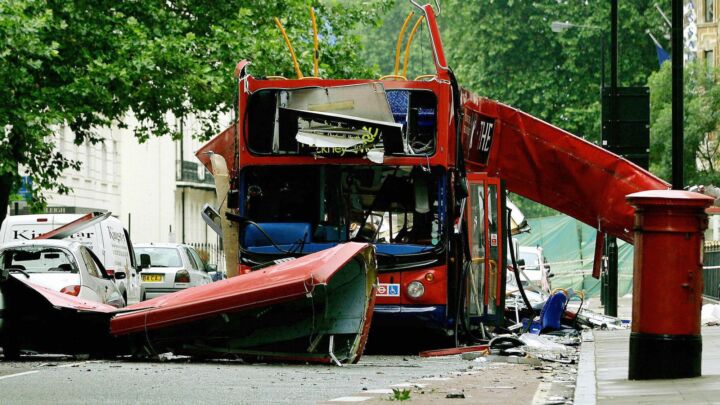Kent State and the death of the Sixties spirit
The massacre marked the beginning of a more cynical and divided era.

Want to read spiked ad-free? Become a spiked supporter.
Fifty years ago, David Crosby handed Neil Young a copy of Life magazine. It featured the Pulitzer Prize-winning photograph of 14-year-old Mary Ann Vecchio kneeling, open-mouthed, over Kent State student Jeffrey Miller’s corpse. It was this horrifying image which, a week after the events, sent Young into a rage. He retreated into the woods and wrote one of the most iconic protest songs ever – ‘Ohio’. The single was performed by Crosby, Stills, Nash and Young, and rushed into production in a sleeve featuring the US Constitution with four bullet holes in it.
The Kent State massacre occurred on 4 May 1970, when 28 National Guard soldiers fired more than 60 rounds over a period of 13 seconds at student protesters at Kent State university in Ohio. They killed four students and wounded nine others, one of whom suffered permanent paralysis. Some of the students who were shot had been protesting against the ‘Cambodian Incursion’, an expansion of the Vietnam War. Other students who were shot had been walking nearby or observing the protest from a distance.
The world changed in 1970. The Kent State shootings, along with Altamont and the Manson murders the previous year, brought to an end the innocence of Woodstock and the Summers of Love. The response to this shooting marked the beginning of a new era where – ironically, considering the success of ‘Ohio’ – organised protest against the US government fragmented and faded. Protest in the 1970s focused on individualised rather than collective concerns. Neil Young, though he wrote ‘Southern Man’, another political song, soon after, drifted rightwards in his politics, eventually expressing support for Ronald Reagan.
The Ohio killings were the dramatic product of a number of factors.
On 30 April, Nixon announced the Cambodian incursion, outraging many because it extended the war into a hitherto neutral country, and had not been approved by Congress. Three days before the shootings, Nixon talked of ‘bums’, by which he meant anti-war protesters on US campuses. The father of one of the victims, Alison Krause, later appeared on national TV to rebuke the president: ‘My child was not a bum.’ Simmering in the background on campuses was anger at the change in December 1969 to the draft procedure, which eliminated deferments allowed previously, affecting many college students and teachers.
Kent State had long suffered ‘town and gown’ problems, and in the run-up to the massacre outspoken Ohio governor James Rhodes – upon hearing rumours of students with caches of arms, plots to spike the local water supply with LSD, and plans to blow up the town’s main store – raised the temperature by echoing Nixon’s condemnation of student protesters: ‘They’re the worst type of people that we harbour in America. Now I want to say this. They are not going to take over campus. I think that we’re up against the strongest, well-trained, militant, revolutionary group that has ever assembled in America.’
Rhodes called in the National Guard on 2 May. That evening the campus building used by the Reserve Officers’ Training Corps, one of the US Army’s primary recruiting tools during the Vietnam War, was burning to the ground. A protest scheduled for Monday 4 April swelled as resentment against the National Guard mixed with outrage against Nixon’s expansion of the war.
University officials attempted to ban the gathering, handing out 12,000 leaflets stating that the event was cancelled. This action only added to the numbers, with protesters now angry that their constitutional rights were being abridged. An estimated 2,000 people gathered on Monday.
At noon, three units of guardsmen advanced on the commons, firing tear-gas canisters as they were pelted with rocks and bottles. But the majority of the guardsmen became hemmed in by a fence at the end of the university sports field. After a 15-minute stand-off with students, they retreated up the hill. Then, at 24 minutes past noon, one group of guardsmen wheeled around to face the students and opened fire. Thirteen seconds and more than 60 shots later, William Schroeder, Sandra Scheuer, Allison Krause and Jeffrey Miller were dead and nine others were injured.
No one knows exactly why the National Guard fired. Interviewed later, guardsmen claimed that shots had been fired from the protesters, but no evidence of anyone firing at the guardsmen has since turned up. Certainly, the students were unarmed.
One of the consequences of the shooting was to create a cleavage between the fiercely anti-communist, pro-trade-union liberalism of the postwar period – the liberalism of Kennedy and Johnson, of the 1963 March on Washington, of Martin Luther King – and the disillusioned younger generation, for whom liberalism represented hypocrisy and the viciousness of the Vietnam War.
There is no doubt some truth to the view that the shootings were also a harbinger of right-wing reaction, which appeared to triumph in the 1970s and culminated in Ronald Reagan’s presidency. While Young’s single sold very well, a Gallup Poll taken the day after the shootings indicated that 58 per cent of respondents blamed the students for the shooting, and only 11 per cent blamed the National Guard. A ‘hardhat riot’ in New York made the news four days later, when construction workers, supportive of the Vietnam War, attacked students demonstrating against it.
Certainly, Nixon, already wondering about his direction, began to distance himself from his more liberal advisers, like Democrat Daniel Patrick Moynihan and Leonard Garment, who had won most of the arguments in Nixon’s first year of office. By September 1970 Nixon complained that the White House had ‘been affected too much by the unreal atmosphere’ of Washington DC: ‘Perhaps Cambodia and Kent State led to an overreaction by our own people to prove that we were pro students, blacks, left. We must get turned around on this before it is too late.’
But it would be a mistake to look at the changes between the 1960s and 70s in stark left and right terms, as Nixon found when he attempted to court a very unenthusiastic hardhat political constituency. Nixon’s November 1969 ‘Silent Majority’ speech identified a new, more passive citizenry that could not be politically organised, but who acquiesced to increasingly technocratic government. The new era that emerged was characterised not by politics but, in the words of Richard Scammon and Ben Wattenberg, by the ‘social issue’.
Kent State marked the beginning of disillusionment with politics, leaders and the possibility of meaningful political change. Given the lack of trust in leaders or institutions – a legacy, in part, of the Vietnam War – cynicism replaced the sometimes naive optimism of previous generations. Millions of students shut down hundreds of universities, colleges and high schools in the days after Kent State. But they did so with no expectation of changing the government’s course on Vietnam – like both Neil Young and the hardhats, this was only an expression of inchoate rage.
Kevin Yuill teaches American studies at the University of Sunderland.
Picture by: YouTube.
Who funds spiked? You do
We are funded by you. And in this era of cancel culture and advertiser boycotts, we rely on your donations more than ever. Seventy per cent of our revenue comes from our readers’ donations – the vast majority giving just £5 per month. If you make a regular donation – of £5 a month or £50 a year – you can become a and enjoy:
–Ad-free reading
–Exclusive events
–Access to our comments section
It’s the best way to keep spiked going – and growing. Thank you!









Comments
Want to join the conversation?
Only spiked supporters and patrons, who donate regularly to us, can comment on our articles.